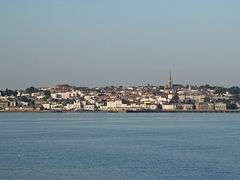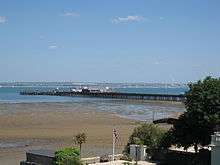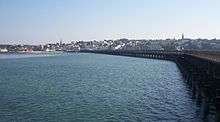Ryde
| Ryde | |
 Ryde viewed from the Solent |
|
 Ryde |
|
| Population | 23,999 (2011 Census) |
|---|---|
| OS grid reference | SZ591923 |
| Unitary authority | Isle of Wight |
| Ceremonial county | Isle of Wight |
| Region | South East |
| Country | England |
| Sovereign state | United Kingdom |
| Post town | RYDE |
| Postcode district | PO33 |
| Dialling code | 01983 |
| Police | Hampshire |
| Fire | Isle of Wight |
| Ambulance | Isle of Wight |
| EU Parliament | South East England |
| UK Parliament | Isle of Wight |
|
|
Coordinates: 50°43′38″N 1°09′42″W / 50.7271°N 1.1618°W
Ryde is a British seaside town and civil parish on the Isle of Wight, with a population of 23,999 at the 2011 Census.[1] It lies on the north-east coast. The town grew in size as a seaside resort after the villages of Upper Ryde and Lower Ryde were merged in the 19th century. The influence of this era is still strongly visible in the town's central and seafront architecture.
As a resort, the town is noted for its expansive sands, which are revealed at low tide, making its pier necessary on the wide beach for a regular passenger service. Ryde Pier is a listed structure, and the fourth longest pier in the United Kingdom, as well as the oldest.[2]
History
In 1782 numerous bodies of men, women and children from HMS Royal George, which sank suddenly at Spithead, were washed ashore at Ryde. Many were buried on land that is now occupied by the Esplanade. A memorial to them was erected in June 2004.
Transport
The hovercraft to Southsea is operated by Hovertravel near the Esplanade close to Ryde Esplanade railway station and the bus station. A catamaran service run by Wightlink operates from Ryde Pier to Portsmouth Harbour which connects with both Island Line trains and mainland trains to London Waterloo. The Island Line Trains service runs from Ryde Pier Head via Ryde Esplanade to Shanklin, a distance of 8 1⁄2 miles (14 km). Ryde St John's Road railway station lies further south in the town. A major bus interchange is situated between Ryde Pier and the Hover Terminal on the Esplanade with frequent services to many island towns and villages. Ryde is the second busiest place in the Southern Vectis network, smaller only to Newport. The most frequent service is route 9 to Newport, running every 10 minutes in the daytime. Other main routes include services 2, 3, 4, 8 and local route 37.[3] An open top bus tour called "The Downs Tour" is also run in the summer.[4]
Amenities

The town's large and long esplanade area has always been an attraction for tourists, especially those day-tripping from the mainland, as the amenities are all available by walking from the pier. A swimming pool, bowls club, ice rink, bowling alley, and boating lake are among the attractions, and there are various children's playgrounds, amusement arcades and cafés.
Ryde has few large public open spaces beyond the esplanade, but areas for public recreation include Appley Park, Puckpool Park, Vernon Square, Simeon Street Recreation Ground, St John's Park, St Thomas' churchyard, Salter Road recreation ground, and Oakfield Football Club.
At one time Ryde had two separate piers; the other being the Victoria Pier, no longer in existence. Ryde has its own inshore rescue service which mostly has to deal with people becoming stranded on sandbanks as the incoming tide cuts them off from the shore. The pier is also a feature of the 67-mile (108 km) Isle of Wight Coastal Path, which is marked with blue signs with a white seagull.
Ryde has a small marina located to the east of Ryde Pier. It is tidal and dries out at low water hence it is more suitable for smaller sailing (bilge keel) and motor cruisers. It has provision for up to 200 boats, either on floating pontoons or leaning against the harbour wall. It has a full-time harbourmaster who posts useful snippets of information on the noticeboard outside the harbour office including weather information, tide times, cruise liner movements and events that occurred on this day in history.
Buildings
The twin church spires clearly visible from the sea belong to All Saints' (the taller) and Holy Trinity churches. All Saints' Church is located in Queens Road on a road junction known as Five Ways. It was designed by George Gilbert Scott and completed in 1872. The spire is 177 feet (54 m) tall. Holy Trinity Church is in Dover Street. It was designed by Thomas Hellyer and completed in 1845.
The town’s Roman Catholic church, St. Mary's, is located in High Street. It was built in 1846 at a cost of £18,000. This was provided by Elizabeth, Countess of Clare. The church was designed by Joseph Hansom inventor of the hansom cab. Other churches include St James Church and St. Michael and All Angels, Swanmore. There are also Baptist, Methodist, United Reformed and Elim churches in the town.[5]

Ryde Castle, situated on the Esplanade, was built c. 1840 as a private house in crenellated style and is now a hotel. It was left heavily damaged after a fire in 2012, and reopened after major restoration in 2013.[6]
Beldornie Tower on Augusta Road was at one point a property of the Earl of Yarborough. The house dates back to the 16th or early 17th century. The house was virtually rebuilt c. 1840 in Gothic-Jacobean style with the addition of a west wing in 1880.[7]
Entertainment
Sited on the Esplanade is an ice rink and a pavilion, converted to house a nightclub and bowling alley feature on the Esplanade, the former being the home of the Isle of Wight's ice-hockey team, the "Wightlink Raiders". Many bars, pubs and restaurants can be found on the Esplanade and on the town's main shopping streets, Union Street and High Street.
The town's local football team was for many years Ryde Sports F.C., now replaced by Ryde Saints F.C. & Ryde F.C. SUNDAY.
Speedway is staged just outside the town. The Isle of Wight Islanders started as members of the Conference League before moving up to the Premier League.
Carnival
Ryde is noted for its carnivals. There are five throughout the year - an Arts Parade in June; Children's, Main and Illuminated processions at the end of August and a Lantern Parade in December. The Carnival at Ryde is the oldest in England. Ryde Carnival remains the island's largest carnival, with local crowds and mainland visitors totalling in excess of 50,000 spectators. Performers consist of community groups, schools, multiple samba and brass bands, stilt walkers and family groups, with over 2,000 performers taking part in August 2006.
In 2001 a London carnival group called Kinetika was brought to the island to teach carnival skills to adults and young people in community workshops. Since Kinetika's input the carnival has been expanding, with its effects felt throughout the island's other carnivals. Near Ryde at Westridge from 2008 until 2011 was the Carnival Learning Centre, funded by the Skills Funding Agency and Arts Council, where carnival skills and crafts were taught.
Famous connections
- Raymond Allen – TV screenwriter (Some Mothers Do 'Ave 'Em), attended Ryde Secondary Modern School.
- William Booth – the founder of the Salvation Army spent the first part of his honeymoon in Ryde.
- Sam Browne – the soldier after whom the belt was named, retired and lived the last years of his life in a house called Argosy on East Hill Road, Ryde.
- Sir Charles Clifford, 4th Baronet (1821–1895) – barrister and Liberal member of Parliament, lived at Westfield House.
- Seb Clover (born 1987) – set a world record in 2003 as the youngest cross-Atlantic solo yachtsman. He was educated at Ryde School with Upper Chine.
- Pablo Fanque (1810–1871) – circus proprietor, equestrian, referenced in The Beatles song, Being for the Benefit of Mr. Kite! performed in Ryde in 1840, and promoted the performances through advertisements in the Hampshire Advertiser.
- William Hutt – colonial administrator, was educated in Ryde and resided at Appley Towers.
- Mark King – the Level 42 musician, originally from Gurnard, opened a pub, Joe Daflos, in Union Street, Ryde in the 1980s.
- John Lennon and Paul McCartney – the title of the song "Ticket to Ride" was inspired by a trip they took to Ryde in the 1960s[8] supposedly visiting Paul’s cousin who worked in the Bow Bars public house in Union Street. McCartney also mentions the Isle of Wight in the song "When I'm Sixty-Four".
- F. G. Loring – writer and naval officer, born in Ryde in 1869.
- Karl Marx – visited Ryde for health reasons in the summer of 1874, staying in Nelson Street.
- Anthony Minghella – the Hollywood director was born in Ryde in 1954. His parents ran a cafe in Ryde High Street.
- Philip Norman – writer, attended Ryde School and has written about his childhood in the town.
- Kieran Page – professional road and track cyclist
- Albert Pollard – historian, born in Ryde on 16 December 1869.
- Michael Sheard – actor (Mr Bronson in Grange Hill; Star Wars) lived in Ryde and died there in 2005.
- Walter Toogood (1874–1914) – professional golfer born in Ryde
- M. J. Trow - military historian and detective fiction writer, taught history and politics at Ryde High School.
- Edward Vernon Utterson – lawyer, one of the Six Clerks in Chancery, literary antiquary, collector and editor, moved from Newport to Beldornie Tower, Pelham Field, Ryde, and set up the Beldornie Press there; he and his wife have memorial tablets in St Thomas's Church, Ryde.
- Melvyn Hayes – actor
- David Icke – writer, public speaker and free thinker resides here.
Gallery
 Ryde from the air
Ryde from the air Map of Ryde from 1945
Map of Ryde from 1945 Ryde, seen from Ryde Pier and showing the twin spires.
Ryde, seen from Ryde Pier and showing the twin spires.- Ryde Marina
See also
References
- ↑ "Town Population 2011". Retrieved 18 October 2015.
- ↑ BBC - "Pier-ing into the future"
- ↑ "Southern Vectis route list". Southern Vectis. Retrieved 2009-12-22.
- ↑ "Southern Vectis Downs Tour". Southern Vectis. Retrieved 2009-12-22.
- ↑ ; ; All three retrieved 2011-09-25.
- ↑ "BBC News - Ryde Castle Hotel partially collapses after fire". bbc.co.uk. 2012-03-18. Retrieved 2012-03-18.
- ↑ "Quick Facts on Beldornie Tower". Go Historic. Go Historic. Retrieved 2014-06-30.
- ↑ Song information - "Ticket to ride"
External links
| Wikivoyage has a travel guide for Ryde. |
![]() Media related to Ryde at Wikimedia Commons
Media related to Ryde at Wikimedia Commons
 "Ryde". Encyclopædia Britannica. 23 (11th ed.). 1911.
"Ryde". Encyclopædia Britannica. 23 (11th ed.). 1911.- Ryde Social Heritage Group
- Ryde Harbour
- Pictures of old Ryde
- Ryde Old Postcards
- Historic Ryde Society
- Ryde Guide and Video